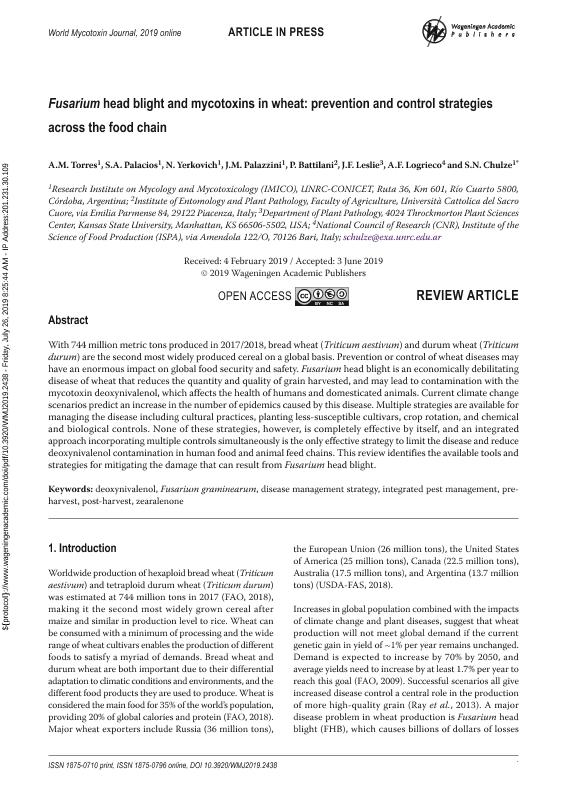Artículo
Fusarium head blight and mycotoxins in wheat: Prevention and control strategies across the food chain
Torres, Adriana Mabel ; Palacios, Sofia Alejendra
; Palacios, Sofia Alejendra ; Yercovich, N.; Palazzini, Juan Manuel
; Yercovich, N.; Palazzini, Juan Manuel ; Battilani, P.; Leslie, J. F.; Logrieco, A.; Chulze, Sofia Noemi
; Battilani, P.; Leslie, J. F.; Logrieco, A.; Chulze, Sofia Noemi
 ; Palacios, Sofia Alejendra
; Palacios, Sofia Alejendra ; Yercovich, N.; Palazzini, Juan Manuel
; Yercovich, N.; Palazzini, Juan Manuel ; Battilani, P.; Leslie, J. F.; Logrieco, A.; Chulze, Sofia Noemi
; Battilani, P.; Leslie, J. F.; Logrieco, A.; Chulze, Sofia Noemi
Fecha de publicación:
06/2019
Editorial:
Wageningen Academic Publishers
Revista:
World Mycotoxin Journal
ISSN:
1875-0710
e-ISSN:
1875-0796
Idioma:
Inglés
Tipo de recurso:
Artículo publicado
Clasificación temática:
Resumen
With 744 million metric tons produced in 2017/2018, bread wheat (Triticum aestivum) and durum wheat (Triticum durum) are the second most widely produced cereal on a global basis. Prevention or control of wheat diseases may have an enormous impact on global food security and safety. Fusarium head blight is an economically debilitating disease of wheat that reduces the quantity and quality of grain harvested, and may lead to contamination with the mycotoxin deoxynivalenol, which affects the health of humans and domesticated animals. Current climate change scenarios predict an increase in the number of epidemics caused by this disease. Multiple strategies are available for managing the disease including cultural practices, planting less-susceptible cultivars, crop rotation, and chemical and biological controls. None of these strategies, however, is completely effective by itself, and an integrated approach incorporating multiple controls simultaneously is the only effective strategy to limit the disease and reduce deoxynivalenol contamination in human food and animal feed chains. This review identifies the available tools and strategies for mitigating the damage that can result from Fusarium head blight.
Archivos asociados
Licencia
Identificadores
Colecciones
Articulos (IMICO)
Articulos de INSTITUTO DE INVESTIGACION EN MICOLOGIA Y MICOTOXICOLOGIA
Articulos de INSTITUTO DE INVESTIGACION EN MICOLOGIA Y MICOTOXICOLOGIA
Citación
Torres, Adriana Mabel; Palacios, Sofia Alejendra; Yercovich, N.; Palazzini, Juan Manuel; Battilani, P.; et al.; Fusarium head blight and mycotoxins in wheat: Prevention and control strategies across the food chain; Wageningen Academic Publishers; World Mycotoxin Journal; 12; 4; 6-2019; 333-355
Compartir
Altmétricas



